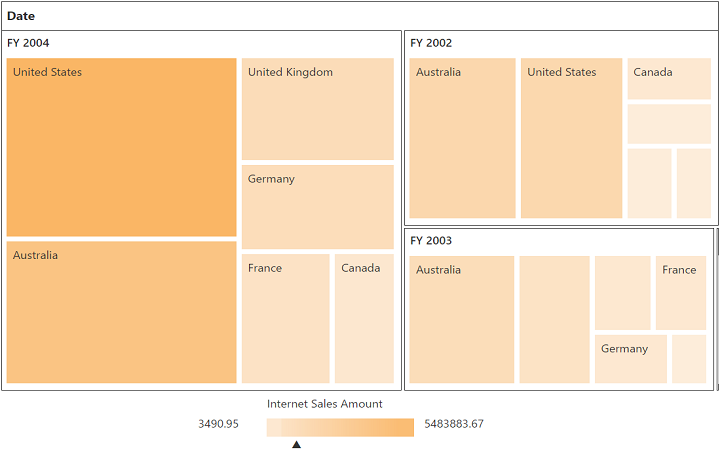Getting Started
29 Sep 20176 minutes to read
This section explains briefly about how to create a PivotTreeMap control in your application with Angular. This section covers only the minimal features that you need to know to get started with the PivotTreeMap.
Getting started with SystemJS
To quick start with Syncfusion JavaScript Angular components run the below commands to clone the repository for SystemJS starter and installing required dependency packages.
> git clone https://github.com/syncfusion/angular2-seeds/ -b systemjs
> cd angular2-seeds
> npm installThe below steps describes to add component with above cloned seed application.
Syncfusion JavaScript components source configuration and sample creation
- Copy required Syncfusion Angular source component(s) from the below build location and add it in
src/ejfolder (For ex., consider thepivottreemapcomponent).
(Installed Location)\Syncfusion\Essential Studio\28.1.33\JavaScript\assets-src\angular2\NOTE
core.tsfile is mandatory for all Syncfusion JavaScript Angular components. The repository having the source file from Essential Studio for JavaScript v28.1.33.
-
Create
pivottreemapfolder insidesrcfolder. -
Create
pivottreemap.component.htmlview file insidesrc/pivottreemapfolder and render ejPivotTreeMap Angular component using the below code example.
<ej-pivottreemap id="PivotTreeMap1" ></ej-pivottreemap>- Create
pivottreemap.component.tsmodel file inside the foldersrc/pivottreemapand create sample component using the below code example.
import { Component } from '@angular/core';
@Component({
selector: 'ej-app',
templateUrl: 'app/components/pivottreemap/pivottreemap.component.html',
styleUrls: ['app/components/pivottreemap/pivottreemap.component.css'],
})
export class PivotTreeMapComponent {
//..
}Configure the routes for the Router
Before adding router configuration for above created ejPivotTreeMap component, we recommend you to go through the Angular Routing configuration to get the deeper knowledge about Angular routing.
- Now, we are going to configure the route navigation link for created PivotTreeMap sample in
src/app.component.htmlfile.
<div>
<ul class="nav navbar-nav">
. . . .
<li><a data-toggle="collapse" data-target="#skeleton-navigation-navbar-collapse.in" href="#pivottreemap" [routerLink]="['/pivottreemap']">PivotTreeMap </a></li>
</ul>
</div>
<main>
<router-outlet></router-outlet>
</main>- Import the ejPivotTreeMap sample component and define the route in
src/app.routes.tsfile.
import { Routes } from '@angular/router';
. . . .
import { PivotTreeMapComponent } from './pivottreemap/pivottreemap.component';
export const rootRouterConfig: Routes = [
{ path: '', redirectTo: 'home', pathMatch: 'full' },
. . . .
{ path: 'pivottreemap', component: PivotTreeMapComponent }
];- Import and declare the Syncfusion source component and ejPivotTreeMap sample component into
app.module.tslike the below code snippet.
import { NgModule, enableProdMode, ErrorHandler } from '@angular/core';
. . . . .
import { EJ_PIVOTTREEMAP_COMPONENTS } from './ej/pivottreemap.component';
import { PivotTreeMapComponent } from './pivottreemap/pivottreemap.component';
import { rootRouterConfig } from './app.routes';
. . . .
@NgModule({
imports: [BrowserModule, FormsModule, HttpModule, RouterModule.forRoot(rootRouterConfig, { useHash: true })],
declarations: [. . . . , EJ_PIVOTTREEMAP_COMPONENTS,PivotTreeMapComponent],
bootstrap: [AppComponent]
})
export class AppModule { }Control Initialization
Add necessary HTML elements in pivottreemap.component.html to render PivotTreeMap
<ej-pivottreemap id="PivotTreeMap1" dataSource.data="http://bi.syncfusion.com/olap/msmdpump.dll" dataSource.catalog="Adventure Works DW 2008 SE" dataSource.cube="Adventure Works" [dataSource.rows]="rows" [dataSource.columns]="columns" [dataSource.values]="values" [dataSource.filters]="filters">
</ej-pivottreemap>Create a CSS page and add necessary CSS elements for PivotTreeMap
.e-pivottreemap {
min-height: 275px;
display: block;
min-width: 525px;
height: 460px !important;
width: 99%
}Populate PivotTreeMap with data
Let us now see how to populate the PivotTreeMap control using a sample data as shown below.
<ej-pivottreemap id="PivotTreeMap1" dataSource.data="http://bi.syncfusion.com/olap/msmdpump.dll" dataSource.catalog="Adventure Works DW 2008 SE" dataSource.cube="Adventure Works" [dataSource.rows]="rows" [dataSource.columns]="columns" [dataSource.values]="values" [dataSource.filters]="filters" (renderSuccess)="renderSuccess($event)">
</ej-pivottreemap>//..
export class PivotTreeMapComponent {
public rows; columns; values; filters;
constructor() {
this.rows = [{ fieldName: "[Date].[Fiscal]" }];
this.columns = [{ fieldName: "[Customer].[Customer Geography]" }];
this.values = [{ measures: [{ fieldName: "[Measures].[Internet Sales Amount]", }], axis: "columns" }];
this.filters = [];
}
renderSuccess(args){
let treemapTarget = $('#PivotTreeMap1TreeMapContainer').data('ejTreeMap');
treemapTarget.model.tooltipTemplate = null;
treemapTarget.model.showTooltip = false;
treemapTarget.refresh();
}
}The above code will generate a simple PivotTreeMap with internet sales amount over a period of fiscal years across different customer geographic locations.
